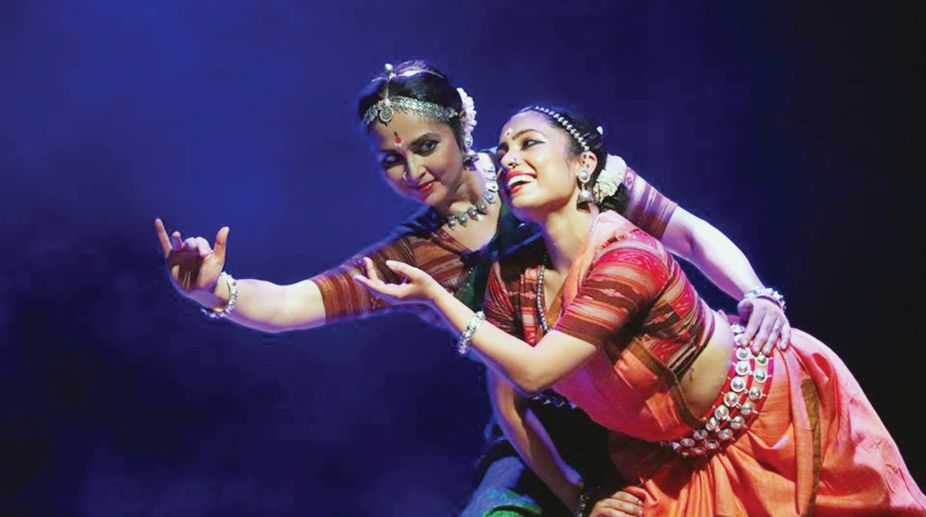The bygone bardic battles of Bengal
Far more than a mere musical pursuit, Kabi Gaan boasts an illustrious heritage, its roots firmly embedded in the fertile soil of 18th century-Bengal’s rural landscape.
Exquisite dance pieces based on mythological stories from popular Indian tales were showcased in all its varied brilliance.

Sparsh brought Murchchana — the eternal spirit of music- to the audience at Kolkata, recently. The group danced in a jam-packed hall. It was amazing to see Rasikas in the city buying high denomination bills for the show. It told much of their expectation, which was more than fulfilled, if one had to go by their expressions of satisfaction as they left Birla Sabhaghar.
Dinesh Poddar, a well known light designer who has been with Sharmila Biswas from the days of Murchchana’s inception said, “the idea of Murchhana had germinated in Biswas’ mind more than two decades ago and was held for the first time at Tivoli Park, where the creation of an ‘Akhada’ like stage design gave the whole concept an authenticity, where mrudanga players of Odisha ritualistically follow the act of mrudanga making at a certain time of the year.”
Over the years Biswas has brought in many changes to this unique production, which draws a thin line between the real and the unreal. Biswas who has the penchant to delve into the lesser known or rather unknown facts and myths, researched into the story of Murchhana to gift us this piece.
Advertisement
During the course of her research on the rural percussion instruments of Odisha, she had often been told the story by mrudanga players. During the annual mrudanga making season or rather the season when “mridangashudddhi” is done, this story is repeatedly told through sweet sounding verses and songs, as a part of mrudanga purification ritual that has been handed down through oral tradition.
These songs were collected assiduously by Biswas and blended with her dance drama with a telling effect, making use of the Natyashashtric “vachika abhinaya”— communicating through the spoken language.
Incidentally Biswas’s aharya abhinaya was also very different from the usual costumes worn by Odissi dancers. This gave the dancers the much needed freedom of movement, besides making them look like rural beauties. Biswas herself looked gorgeous in this simple costume.
Utilising the element of drama, she mesmerised the audience into believing, that when a man plays the mrudanga, with his whole being immersed in his art, Murchhana, the spirit of music, enters and possesses the mrudanga, stirring the person from within and transforming him, elevating his art to a spiritual level causing supreme bliss.
Enacting the inspirational effect of mythological stories from three popular Indian tales told by mrudangists, Biswas explored the concept of Murchhana. These stories made her presentation a spectacular show, drawing awareness to the rich lore of the country.
First story described Rambha and Brahma discovering simple and primitive music in the newly born universe. Exploration of the sounds coming from deep inside the earth by Rambha, heard by Brahma who moulded himself inside the mrudanga, giving birth to Sangit expressed through the joyful dancing of the girls holding the new born mrudanga was a-one-of-its-kind conceptualisation.
The next legend told through dance about the creation of the mrudanga, after Rambha left the scene, causing the destruction of the instrument, was about music arising from Sringar rasa or the flavours of love, which brought us to the second story.
This time the mrudanga artists sang the story of the churning of the milk ocean by the suras-gods-and the asuras -demons-for immortality where Vishnu had taken the form of Mohini- the most charming maiden.
The mrudanga was brought alive once more by the gods, after Mohini left the scene with the evocation of “Raasleela”. Krishna provided the structure when he transformed the body of the extremely powerful Tungavidiya Sakhi — a gopi-well-versed in the knowledge of all branches of the arts into the mrudanga and danced the Rasleela. This rejuvenation of the mrudanga happened during Dwapar Yuga-the Mahabharata period.
The story of Murchhana is romantic and Biswas has been initiated into it by Dhanurdhar Reddy who was a mrudangist as well as a khol player. Its rustic spirituality was woven through story-telling devise in a manner not seen before.
The dancers with their fine-tuned bodies used the whole stage, dancing ecstatically to the folk music of the mrudangists who sang quaint songs in Odia of the spirit of the gods entering the mrudanga to recreate it to suit the times.
The fruits of Biswas’s search presented through nritta, nritya and natya according to the tenets of the Natya Shashtra was savoured. Srijan Chatterjee’s music composition along with the rhythm composition of Bijaya Kumar Barik; scripted by Biswas and Shuktara Lal; the vocal renditions of Tamonash Chakravarty, DukhishyamTripathy (adapted from the original verses); with the work of the light and sound designers Dinesh Poddar and Soumitra Das, the presentation struck the imagination of the audience.
Set designer Nandagopal Jana and the performers Monami Nandi, Rohini Banerjee, Tri Paul, Krishnendu Saha, Riya Saha, Riti Majumdar, Debottama Sarkar and of course Biswas set the stage on fire.
Mrudanga Gurus Prahlad Baral, Dhanurdhar Reddy, Padmacharan Behera and others have richly contributed with the content of the production.
Advertisement